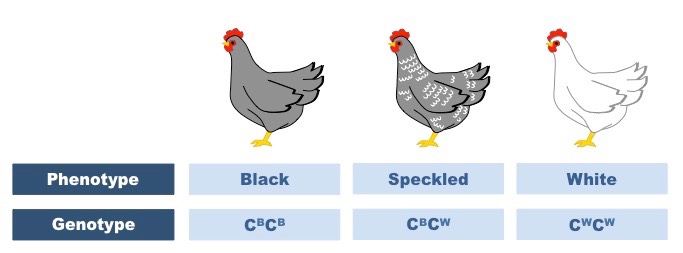![]()
Understanding:
• Dominant alleles mask the effect of recessive alleles but co-dominant alleles have joint effects
The gene composition (i.e. allele combination) for a specific trait is referred to as the genotype
- The genotype of a particular gene will typically be either homozygous or heterozygous
The observable characteristics of a specific trait (i.e. the physical expression) is referred to as the phenotype
- The phenotype is determined by both the genotype and environmental influences
Complete Dominance
Most traits follow a classical dominant / recessive pattern of inheritance, whereby one allele is expressed over the other
- The dominant allele will mask the recessive allele when in a heterozygous state
- Homozygous dominant and heterozygous forms will be phenotypically indistinguishable
- The recessive allele will only be expressed in the phenotype when in a homozygous state
When representing alleles, the convention is to capitalise the dominant allele and use a lower case letter for the recessive allele
- An example of this mode of inheritance is mouse coat colour – black coats (BB or Bb) are dominant to brown coats (bb)
Complete Dominance (Mouse Coat Colour)

Co-dominance
Co-dominance occurs when pairs of alleles are both expressed equally in the phenotype of a heterozygous individual
- Heterozygotes therefore have an altered phenotype as the alleles are having a joint effect
When representing alleles, the convention is to use superscripts for the different co-dominant alleles (recessive still lower case)
- An example of co-dominance is feathering in chickens – black (CB) and white (CW) feathers create a speckled coat (CBCW)
Co-dominance (Chicken Feathering)

![]()
Application:
• Inheritance of ABO blood groups
Human red blood cells can be categorised into different blood groups based on the structure of a surface glycoprotein (antigen)
- The ABO blood groups are controlled by a single gene with multiple alleles (A, B, O)
The A, B and O alleles all produce a basic antigen on the surface of red blood cells
- The A and B alleles are co-dominant and each modify the structure of the antigen to produce different variants
- The O allele is recessive and does not modify the basic antigenic structure
When representing blood group alleles, the letter I is used to represent the different antigenic forms (isoantigens)
- A allele = IA ; B allele = IB ; O allele = i (recessive)
The genotypes for the different blood groups can be summarised as follows:

As humans produce antibodies against foreign antigens, blood transfusions are not compatible between certain blood groups
- AB blood groups can receive blood from any other type (as they already possess both antigenic variants on their cells)
- A blood groups cannot receive B blood or AB blood (as the isoantigen produced by the B allele is foreign)
- B blood groups cannot receive A blood or AB blood (as the isoantigen produced by the A allele is foreign)
- O blood groups can only receive transfusions from other O blood donor (both antigenic variants are foreign)
Summary of the ABO Blood Groups

The Consequence of an Incompatible Blood Transfusion

